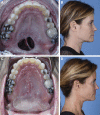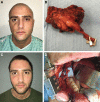Avoiding Facial Incisions with Midface Free Tissue Transfer
- PMID: 28280662
- PMCID: PMC5340477
- DOI: 10.1097/GOX.0000000000001218
Avoiding Facial Incisions with Midface Free Tissue Transfer
Abstract
Background: We have adopted an intraoral microsurgical anastomosis to the facial vessels to eliminate the need for any visible facial incisions.
Methods: Cadaveric dissection was used to demonstrate accessibility of the facial artery and vein through an intraoral approach. Additionally, 5 patients underwent free tissue transfer for reconstruction of major defects of the midface through an intraoral, transmucosal approach, obviating the need for visible skin incisions.
Results: The pathology included palatal defects due to mucoepidermoid carcinoma and ischemic necrosis from cocaine abuse, maxillary defects secondary to fibrous dysplasia and avascular necrosis from traumatic blast injury, and a residual posttraumatic bony deformity of the zygoma. Reconstructions were performed with a free ulnar forearm flap, a free vastus lateralis muscle flap, a deep circumflex iliac artery myoosseous flap, a free fibula flap, and a deep circumflex iliac artery osseous flap, respectively. The facial artery and vein were used as recipient vessels for microvascular anastomosis for all cases. Mean follow-up was 12.2 months. All free tissue transfers were successful, and each patient had a satisfactory aesthetic outcome with no associated facial scars.
Conclusion: This technique can be employed during reconstruction of an array of bony or soft-tissue midface deficits with minimal morbidity. This small series effectively demonstrates the varied pathologies and tissue deficiencies that can be successfully reconstructed with free tissue transfer using an entirely intraoral approach to the recipient facial vessels, resulting in no visible scars on the face and an improvement in the overall aesthetic outcome.
Figures




References
-
- Chang CC, Huang WC, Lin JY, et al. Perforator flap from proximal lateral leg for head and neck reconstruction. J Reconstr Microsurg. 2013;29:263–270. - PubMed
-
- Chen SL, Yu CC, Chang MC, et al. Medial sural artery perforator flap for intraoral reconstruction following cancer ablation. Ann Plast Surg. 2008;61:274–279. - PubMed
-
- Coyle MJ, Tyrrell R, Godden A, et al. Replacing tracheostomy with overnight intubation to manage the airway in head and neck oncology patients: towards an improved recovery. Br J Oral Maxillofac Surg. 2013;51:493–496. - PubMed
-
- Gaggl A, Bürger H, Virnik SA, et al. An intraoral anastomosing technique for microvascular bone flaps in alveolar ridge reconstruction: first clinical results. Int J Oral Maxillofac Surg. 2009;38:921–927. - PubMed
LinkOut - more resources
Full Text Sources
Other Literature Sources
Research Materials
